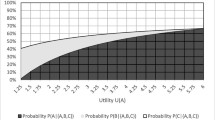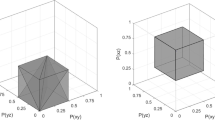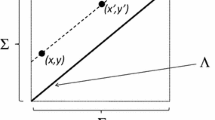Abstract
One of the most well-known theories of decision making under risk is expected utility theory based on the independence axiom. The independence axiom postulates that decision maker’s preferences between two lotteries are not affected by mixing both lotteries with the same third lottery (in identical proportions). The probabilistic independence axiom (also known as the cancelation axiom) extends this classic independence axiom to situations when a decision maker chooses in a probabilistic manner (i.e., she does not necessarily prefer the same choice alternative when repeatedly presented with the same choice set). Probabilistic choice may occur for a variety of reasons such as unobserved attributes of choice alternatives, imprecision of preferences, random errors/noise in decisions. According to probabilistic independence axiom, the probability that a decision maker chooses one lottery over another does not change when both lotteries are mixed with the same third lottery (in identical proportions). This paper presents a model of probabilistic binary choice under risk based on this probabilistic independence axiom. The presented model generalizes an incremental expected utility advantage model of Fishburn (Int Econ Rev 19(3):633–646, 1978) and stronger utility model of Blavatskyy (Theory Decis 76(2):265–286, 2014).



Similar content being viewed by others
Notes
Machina (1985) and Chew et al. (1991) develop models of probabilistic choice under risk as a result of deliberate randomization by decision makers with (deterministic) quasi-concave preferences. Carbone and Hey (1995) find that conscious randomization cannot rationalize their experimental data but Agranov and Ortoleva (2017) reach the opposite conclusion.
An outside observer cannot observe choice decisions when a decision maker faces a binary choice between two identical lotteries.
i.e., when one lottery does not first-order stochastically dominate the other.
Other possible distributions of random errors are detailed in Blavatskyy (2014, p. 270).
i.e., utility of the least desirable outcome is zero and utility of the most desirable outcome is one.
For any two lotteries \(L, L^{\prime} \in {\mathcal{L}},\) a contextual probability equivalent of lottery L is probability α ∈ [0,1] such that a decision maker is indifferent between L and a compound lottery that yields the least upper bound on L and L′ (in terms of the first-order stochastic dominance) with probability α and the greatest lower bound on L and L′ (in terms of the first-order stochastic dominance) with probability 1 − α. Under expected utility theory, contextual probability equivalents of any two lotteries should sum up to one.
References
Agranov, M., and P. Ortoleva. 2017. Stochastic choice and preferences for randomization. Journal of Political Economy 125 (1): 40–68.
Ballinger, P., and N. Wilcox. 1997. Decisions, error and heterogeneity. Economic Journal 107: 1090–1105.
Bernoulli, D. 1738. Specimen theoriae novae de mensura sortis. Commentarii Academiae Scientiarum Imperialis Petropolitanae; translated in Bernoulli, D. (1954) Exposition of a new theory on the measurement of risk. Econometrica 22: 23–36.
Blavatskyy, Pavlo. 2008. Stochastic utility theorem. Journal of Mathematical Economics 44 (11): 1049–1056.
Blavatskyy, Pavlo. 2009. Preference reversals and probabilistic choice. Journal of Risk and Uncertainty 39 (3): 237–250.
Blavatskyy, Pavlo. 2011. A model of probabilistic choice satisfying first-order stochastic dominance. Management Science 57 (3): 542–548.
Blavatskyy, Pavlo. 2012. Probabilistic choice and stochastic dominance. Economic Theory 50 (1): 59–83.
Blavatskyy, Pavlo. 2014. Stronger utility. Theory and Decision 76 (2): 265–286.
Butler, David J., and Graham C. Loomes. 2007. Imprecision as an account of the preference reversal phenomenon. American Economic Review 97 (1): 277–297.
Butler, David J., and Graham C. Loomes. 2011. Imprecision as an account of violations of independence and betweenness. Journal of Economic Behavior & Organization 80: 511–522.
Camerer, Colin F. 1989. An experimental test of several generalized utility theories. Journal of Risk and Uncertainty 2 (1): 61–104.
Carbone, E., and J. Hey. 1995. A comparison of the estimates of EU and non-EU preference functionals using data from pairwise choice and complete ranking experiments. Geneva Papers on Risk and Insurance Theory 20: 111–133.
Chew, S., L. Epstein, and U. Segal. 1991. Mixture symmetry and quadratic utility. Econometrica 59: 139–163.
Falmagne, Jean-Claude. 1985. Elements of psychophysical theory. New York: Oxford University Press.
Fechner, Gustav. 1860. Elements of psychophysics. New York: Holt, Rinehart and Winston.
Fishburn, Peter. 1978. A probabilistic expected utility theory of risky binary choices. International Economic Review 19 (3): 633–646.
Gul, F., and W. Pesendorfer. 2006. Random expected utility. Econometrica 71 (1): 121–146.
Harless, D., and C. Camerer. 1994. The predictive utility of generalized expected utility theories. Econometrica 62: 1251–1289.
Hey, J.D. 2001. Does repetition improve consistency? Experimental Economics 4: 5–54.
Hey, John D., and Chris Orme. 1994. Investigating generalisations of expected utility theory using experimental data. Econometrica 62: 1291–1326.
Jensen, J. 1906. Sur les fonctions convexes et les inégalités entre les valeurs moyennes. Acta Mathematica 30 (1): 175–193.
Loomes, Graham. 2005. Modelling the stochastic component of behaviour in experiments: some issues for the interpretation of data. Experimental Economics 8: 301–323.
Loomes, Graham, and Robert Sugden. 1995. Incorporating a stochastic element into decision theories. European Economic Review 39: 641–648.
Loomes, Graham, and Robert Sugden. 1998. Testing different stochastic specifications of risky choice. Economica 65: 581–598.
Loomes, Graham, Peter Moffatt, and Robert Sugden. 2002. A microeconomic test of alternative stochastic theories of risky choice. Journal of Risk and Uncertainty 24: 103–130.
Luce, R.D. 1959. Individual choice behavior. New York: Wiley.
Machina, M. 1985. Stochastic choice functions generated from deterministic preferences over lotteries. Economic Journal 95: 575–594.
McFadden, D. 1976. Quantal choice analysis: A survey. Annals of Economic and Social Measurement 5: 363–390.
Pascal, Blaise. 1670. Pensées de M. Pascal sur la religion et sur quelques autres sujets, qui ont esté trouvées après sa mort parmy ses papiers. édition de Port-Royal, Paris, chez Guillaume Desprez.
Seidl, C. 2002. Preference reversal. Journal of Economic Surveys 16: 621–655.
Starmer, Chris, and Robert Sugden. 1989. Probability and juxtaposition effects: An experimental investigation of the common ratio effect. Journal of Risk and Uncertainty 2: 159–178.
Tversky, A., P. Slovic, and D. Kahneman. 1990. The causes of preference reversal. American Economic Review 80: 204–217.
von Neumann, John, and Oscar Morgenstern. 1947. Theory of games and economic behavior, 2nd ed. Princeton: Princeton University Press.
Wilcox, N. 2008. Stochastic models for binary discrete choice under risk: A critical primer and econometric comparison. In Research in experimental economics, vol. 12, ed. J.C. Cox and G.W. Harrison, 197–292. Bingley: Emerald.
Wilcox, N. 2011. Stochastically more risk averse: A contextual theory of stochastic discrete choice under risk. Journal of Econometrics 162: 89–104.
Funding
Pavlo Blavatskyy is a member of the Entrepreneurship and Innovation Chair, which is part of LabEx Entrepreneurship (University of Montpellier, France) and funded by the French government (Labex Entreprendre, ANR-10-Labex-11-01).
Author information
Authors and Affiliations
Corresponding author
Ethics declarations
Conflict of interest
The author declares that he has no conflict of interest.
Appendix
Appendix
Proof of Proposition 1
Consider any two distinct lotteries \(L\left( {p_{ 1} , \ldots ,p_{n} } \right) \in {\mathcal{L}}{\text{ and}}\;L^{{\prime }} \left( {q_{ 1} , \ldots ,q_{n} } \right) \in {\mathcal{L}}\) such that pi≥ qi for all i ∊ {1,…,k} and qj> pj for all j ∊ {k + 1,…,n} for some k ∊ {1,…,n − 1}.
First, lottery L′(q1,…,qn) is a reduced-form of a compound lottery \(q_{ 1} \varvec{x}_{{\mathbf{1}}} \, + \,\left( { 1 - q_{ 1} } \right)L_{1}^{{\prime }} ,\) where x1 denotes a degenerate lottery that yields outcome x1 for sure and \(L_{1}^{{\prime }}\) denotes lottery
Similarly, lottery L(p1,…,pn) is a reduced-form of a compound lottery \(q_{ 1} \varvec{x}_{{\mathbf{1}}} \, + \,\left( { 1- q_{ 1} } \right)L_{ 1} ,\) where L1 denotes lottery
If Axiom 1 holds then \(P\left( {L,L^{{\prime }} } \right)\, \equiv \,P\left( {q_{ 1} x_{{\mathbf{1}}} \, + \,\left( { 1- q_{ 1} } \right)L_{ 1} ,q_{ 1} x_{{\mathbf{1}}} \, + \,\left( { 1- q_{ 1} } \right)L_{1}^{{\prime }} } \right)\, = \,P\left( {L_{ 1} ,L_{1}^{{\prime }} } \right).\)
Second, \(L_{1}^{{\prime }}\) is a reduced-form of a compound lottery \(\left[ {q_{ 2} /\left( { 1 - q_{ 1} } \right)} \right]\varvec{x}_{{\mathbf{2}}} \, + \,\left[ { 1 - q_{ 2} /\left( { 1 - q_{ 1} } \right)} \right]L_{2}^{{\prime }} ,\) where x2 denotes a degenerate lottery that yields outcome x2 for sure and \(L_{2}^{{\prime }}\) denotes lottery
Similarly, lottery L1 is a reduced-form of a compound lottery \(\left[ {q_{ 2} /\left( { 1 - q_{ 1} } \right)} \right]\varvec{x}_{{\mathbf{2}}} \, + \,\left[ { 1 - q_{ 2} /\left( { 1 - q_{ 1} } \right)} \right]L_{2} ,\) where L2 denotes lottery
If Axiom 1 holds then \(P\left( {L_{ 1} ,L_{1}^{{\prime }} } \right)\, \equiv \,P\left( {\left[ {q_{ 2} /\left( { 1- q_{ 1} } \right)} \right]x_{{\mathbf{2}}} \, + \,\left[ { 1- q_{ 2} /\left( { 1- q_{ 1} } \right)} \right]L_{ 2} ,\left[ {q_{ 2} /\left( { 1- q_{ 1} } \right)} \right]x_{{\mathbf{2}}} \, + \,\left[ { 1- q_{ 2} /\left( { 1- q_{ 1} } \right)} \right]L_{2}^{{\prime }} } \right)\, = \,P\left( {L_{ 2} ,L_{2}^{{\prime }} } \right).\)
Iterating such application of Axiom 1 for the first k outcomes we obtain that \(P\left( {L,L^{{\prime }} } \right)\, = \,P\left( {L_{k} ,L_{k}^{{\prime }} } \right),\) where Lk denotes lottery
and \(L_{k}^{{\prime }}\) denotes lottery
Lottery Lk is a reduced form of a compound lottery
where xk+1 denotes a degenerate lottery that yields outcome xk+1 for sure and Lk+1 denotes lottery
Similarly, lottery \(L_{k}^{{\prime }}\) is a reduced form of a compound lottery
where \(L_{k + 1}^{{\prime }}\) denotes lottery
Axiom 1 then implies \(P\left( {L_{k} ,L_{k}^{{\prime }} } \right)\, = \,P\left( {L_{k + 1} ,L_{k + 1}^{{\prime }} } \right).\)
Iterating such application of Axiom 1 for the remaining n − k − 1 outcomes we obtain that \(P\left( {L,L^{{\prime }} } \right)\, = \,P\left( {L_{n} ,L_{n}^{{\prime }} } \right)\) where Ln denotes lottery
and \(L_{n}^{{\prime }}\) denotes lottery
The last non-zero probability in lottery Ln is one minus the sum of the first k − 1 probabilities:
The last probability in lottery \(L_{n}^{{\prime }}\) is one minus the sum of the proceeding n − k − 1 probabilities:
Thus, P(L,L′) can be written as function (1) of n − 2 probabilities, where function \(F:\left[ {0,1} \right]^{n - 2} \to \left[ {0,1} \right]\) denotes the probability that a decision maker chooses lottery Ln over lottery \(L_{n}^{{\prime }} .\)****
Rights and permissions
About this article
Cite this article
Blavatskyy, P. Probabilistic independence axiom. Geneva Risk Insur Rev 46, 21–34 (2021). https://doi.org/10.1057/s10713-019-00046-8
Received:
Accepted:
Published:
Issue Date:
DOI: https://doi.org/10.1057/s10713-019-00046-8




